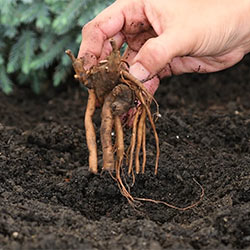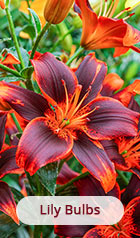They're a perfect complement in woodland gardens or along a shaded walkway. Ferns come in a wide variety of colors and shapes for a unique display in the shade perennial garden. Individual fronds make exceptional additions to cut-flower arrangements and indoor bouquets. Ferns grow well in full shade or partial shade—those areas that receive some direct sunlight for a few hours each day. For a more in—depth overview of ferns, make sure to check out our
care tips for ferns for more information.
If you're looking for more shade-loving plants, you can browse our entire selection of shade perennials.
What type of fertilizer do ferns need?
Fern plants, whether grown as indoor houseplants or outdoor foliage, aren't heavy feeders. Remember, ferns grow naturally in sparse woodland settings, with rich organic matter but little soil depth, and little fertilization. We recommend using a balanced fertilizer, like 10-10-10, when the leaves begin to sprout in the spring. Use a water-soluble plant food, or work granulated fertilizer into the top few inches of soil. Just one feeding per season should be enough for most ferns, and too much feeding can result in "burnt" tips on the leaves.
What type of soil should ferns be planted in?
In their natural woodland settings, ferns live in light soil, scattered with leaves and decomposing bark of taller plants. Replicate that setting in your own yard by adding organic material to your shade garden. Aerate the soil before planting, adding loam, peat moss, or a light bark to the soil. If you're potting ferns, use a potting medium with lots of perlite or loam for the best results.
Can ferns be propagated?
Ferns reproduce from spores, rather than seeds, and can be propagated in soil-if you don't mind a bit of a process. Luckily, ferns are much more easily propagated through cuttings! The best time to divide ferns is in the spring. Dig up and gently pull your fern from the soil. Then, pull or cut the plant into two or three clumps, using a garden fork or clean knife. Make sure that each clump has several roots, as well as a healthy growing tip. Then, reset the plants in soil, and keep them well-watered.
When should I plant ferns?
Ferns are best planted in the spring, after any threat of frost has passed. These plants are hardy but tender, so springtime planting allows them a season to become established before winter. If you're growing ferns indoors, keep them inside until after the final frost date in your zone.
How much water do ferns need?
Ferns prefer their soil to be consistently moist-never wet for days on end, and never dried out. Watering will depend upon your garden's soil type, precipitation, and humidity level. Adding loam or peat moss to the soil can help the soil retain moisture without becoming waterlogged.
When should you bring ferns inside?
Hardy ferns will lose their foliage and can be left outside in the winter, if planted in the ground. Evergreen ferns can also stay outside year-round. For ferns that require warmer climates, bring them in before frost-especially if you'd like to enjoy their foliage in your home through the cold season.






















